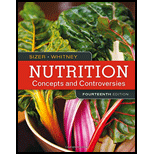
Nutrition: Concepts and Controversies
14th Edition
ISBN: 9781305886865
Author: Sizer, Frances , WHITNEY, Ellie
Publisher: Cengage Learning
expand_more
expand_more
format_list_bulleted
Question
Chapter 5, Problem 7SC
Summary Introduction
Introduction:
Bile is produced by the liver that helps in lipid digestion in small intestine and it is green or yellowish brown color fluid.
Expert Solution & Answer
Trending nowThis is a popular solution!

Chapter 5 Solutions
Nutrition: Concepts and Controversies
Knowledge Booster
Similar questions
- Digestion is completed and products are absorbed in the _________. a. mouth b. stomach c. small intestine d. large intestinearrow_forwardFigure 34.11 Which of the following statements about the digestive system is false? Chyme is a mixture of food and digestive juices that is produced in the stomach. Food enters the large intestine before the small intestine. In the small intestine, chyme mixes with bile, which emulsifies fats. The stomach is separated from the small intestine by the pylloric sphincter.arrow_forwardFigure 34.19 Which of the following statements about digestive processes is true? Amylase, maltaseT and lactase in the mouth digest carbohydrates. Trypsin and lipase in the stomach digest protein. Bile emulsifies lipids in the small intestine. No food is absorbed until the small intestine.arrow_forward
- Bile has a role in _________ digestion and absorption. a. carbohydrate c. protein b. fat d. amino acidarrow_forwardFigure 16.7 Which of the following statements about the digestive system is false? a. Chyme is a mixture of food and digestive juices that is produced in the stomach. b. Food enters the large intestine before the small intestine. c. In the small intestine, chyme mixes with bile, which emulsifies fats. d. The stomach is separated from the small intestine by the pyloric sphincter.arrow_forwardWhich of the following statements is not true? a. Essential nutrients can be synthesized by the body. b. Vitamins are required in small quantities for bodily function. c. Some amino acids can be synthesized by the body, while others need to be obtained from diet. d. Vitamins come in two categories: fat-soluble and water-soluble.arrow_forward
- Figure 34.12 Which of the following statements about the small intestine is false? Absorptive cells that line the small intestine have microvilli, small projections that increase surface area and aid in the absorption of food. The inside of the small intestine has many folds, called villi. Microvilli are lined with blood vessels as well as lymphatic vessels. The inside of the small intestine is called the lumen.arrow_forwardWhere does the majority of fat digestion take place? a. mouth b. stomach c. small intestine d. large intestinearrow_forwardMatch the digestive system parts and functions.arrow_forward
arrow_back_ios
arrow_forward_ios
Recommended textbooks for you
 Human Biology (MindTap Course List)BiologyISBN:9781305112100Author:Cecie Starr, Beverly McMillanPublisher:Cengage Learning
Human Biology (MindTap Course List)BiologyISBN:9781305112100Author:Cecie Starr, Beverly McMillanPublisher:Cengage Learning- Essentials of Pharmacology for Health ProfessionsNursingISBN:9781305441620Author:WOODROWPublisher:Cengage



Human Biology (MindTap Course List)
Biology
ISBN:9781305112100
Author:Cecie Starr, Beverly McMillan
Publisher:Cengage Learning

Essentials of Pharmacology for Health Professions
Nursing
ISBN:9781305441620
Author:WOODROW
Publisher:Cengage

